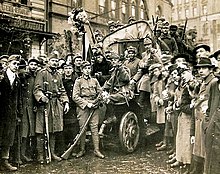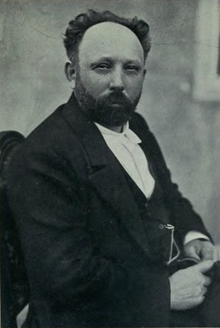Anarchism in Hungary
Anarchist ideas were briefly expressed during the Hungarian Revolution of 1956 but remained largely suppressed until the fall of socialism, which gave way to a third wave of anarchism in Hungary.
[1] This period of political repression remained in place until the Austro-Hungarian Compromise of 1867,[2] which established a dual monarchy with Hungarian sovereignty over the "Lands of the Crown of Saint Stephen".
The group quickly grew to include over 75,000 members and organized peasant strikes, but was repressed by the state, which imposed fines on farmworkers that abstained from work.
[6] Ervin Szabó had also attempted to organise an internal opposition within the Social Democratic Party, in an effort to reform its platform towards a more radical agrarian politics.
[7] At the turn of the 20th century, Ervin Batthyany began to establish clubs, reading rooms and schools to educate people through anarchist means.
At the time the Catholic Church held a monopoly on the education system, as such Batthyany's establishments were described by the clergy as "ungodly" and one of his schools was attacked by a clericalist mob.
[8] Ervin Szabó was one of the early organizers in the movement against Hungarian participation in World War I, agitating alongside György Lukács, Mihály Babits and Béla Balázs.
[10] Propaganda work was spearheaded by the anarchist writer Lajos Kassák, who published the anti-war paper A Tett, fusing his avant-garde style with a principled opposition to the militarism of the Central Powers, but was censored by the Hungarian authorities.
From September 1917, Szabó arranged regular meetings with members of the Galileo Circle and Ilona Duczyńska, during which they decided on the publication of a manifesto based on the line of the Zimmerwald movement and organized a street demonstration against the war, which led many more activists to join the group.
[14] A sustained series of workers' strikes, peasants' rebellions and mutinies within the armed forces eventually led to the collapse of the Hungarian War Cabinet.
Kun attempted to form a coalition of all the dissident socialist tendencies in the country and, though skeptical of the plan, anarchists reluctantly participated at the encouragement of Tibor Szamuely.
In March 1919, the escalating revolutionary sentiment culminated in a general strike, which forced the resignation of the government, freed the Communist Party leaders from prison and eventually led to the establishment of the Hungarian Soviet Republic.
Other anarchist actions included the arson of an army supply depot, an attack against a military plant on the border with Yugoslavia and the organization of a prison riot.
[38] In October 1944, after Horthy had attempted to declare an armistice, the Nazi occupiers overthrew his regime and brought about the establishment of the Nazi-aligned Government of National Unity under Ferenc Szálasi and the Arrow Cross Party.
Anarchist squads wearing red sashes carried out several attacks against Nazi positions around Budapest and acts of sabotage on Nazi-controlled infrastructure.
The Hungarian anarchist movement thus applied to be legalised and formally constituted, which was briefly granted, but permission was swiftly withdrawn by Kliment Voroshilov.
[42] The country's new leader Mátyás Rákosi developed a strong cult of personality,[43] imitating Stalinist political and economic programs, which resulted in Hungary experiencing one of the harshest dictatorships in Europe.
[44][45] Although the Hungarian Revolution of 1956 briefly overthrew Stalinist rule and brought power into the hands of workers' councils,[46] this revolt was crushed by the Soviet forces, which established János Kádár as the new leader of Hungary.
Kádár's administration implemented a policy known as Goulash Communism, a reformed system that aimed to increase living standards and introduce a regulated market economy.
The Revolutions of 1989 brought about the end of communism in Hungary and the country transitioned towards liberal democracy, complete with freedom of speech, association and assembly.




